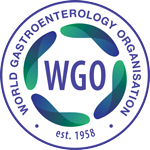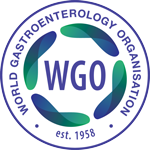Colorectal Cancer in More and Less Developed Countries
Vol. 17, Issue 1 (March 2012)
 |
René Lambert, MD
Screening Group
I.A.R.C., Lyon, France
|
The burden
The number of new cases of colorectal cancer (CRC) occurring in a year is expressed per 100,000 persons of the concerned population. The crude incidence rate, based on the actual age distribution in the population represents the actual burden of the disease in that country. However, the proportion of people in different age classes influences this rate and comparisons between countries require reference to a fixed standard (World Population in 1960). In each country, the incidence of CRC is expressed as the Age Standardized Rate (ASR)/100,000 persons. Similarly, the annual number of deaths from this cancer, occurring in a year, is expressed as ASR mortality/ 100,000 persons. Survival of CRC cases included in cancer registries is expressed at 5 years after detection and takes into account survival in a control population without CRC of the same country; this is the 5-year Relative Survival (5-yRS). Survival depends on the stage of the tumor at detection; in the period 1990-1999 the 5-yRS of colon cancer in the USA (SEER 12 registries), was 96% for Stage I localized cancer and only 6% for stage IV cancer.
Hereditary and sporadic cancer
In a small proportion, not over 5% of cases, CRC occurs as a hereditary disease, through genetic transmission by one ascendant. These include familial adenomatous polyposis (FAP) with transmission of a mutation on chromosome 5, and Lynch syndrome, a non-polyposis syndrome (HNPCC) with microsatellite instability (genes MSH2, MSH6) provoking secondary mutations in the original genome of the descendant. Usually CRC is a sporadic disease; then the risk is influenced by exogenous causal factors. Cases of sporadic cancer may occur under the influence of the same environmental causal factors in closely related parents, offering a similar multi-chromosomal genetic profile.
More and less developed countries
Countries are first classified in geographical regions of Africa, America, Asia, Europe and Oceania. With respect to human development, countries are more or less developed. More developed countries include North America, Europe, Australia and Japan; less developed countries are predominant in Asia, Africa, Latin America and the Caribbean. Those less developed countries showing rapid growth and industrialization are called “emerging”; this applies to Brazil, Russia, India and China, called the BRICs. In complement, a classification of the Gross National Income (GNI) per capita is published for each country by the World Bank and based on the final income (in US Dollars) of each country during one year, divided by the number of the population. According to the most recent (2011) estimations, the GNI per capita is $1,000 or less, for countries in the group Low Income; $1,000 to $4,000 for countries in the group Lower Middle Income; $4,000 to $12,000 for countries in the group Upper Middle Income; and more than $12,000 for countries in the group High Income.
Factors influencing the burden
The risk of sporadic CRC increases with age and is influenced by smoking and by other diseases such as inflammatory bowel disease and diabetes. Causal factors linked to the style of life and to the global resources and economics, differ between more and less developed countries with an impact on incidence (and correlative mortality) of CRC: Incidence is higher in countries classified in the Upper Middle and in the Upper Income groups:
1. A diet rich in calories of animal origin, including red and processed meat and poultry, is a source of overweight, resistance to insulin and production of insulin-like growth factors like IGF-1 which stimulate the proliferation of intestinal cells. In addition, aromatic polycyclic molecules with a carcinogenic impact develop within meat directly grilled on the flame at a high temperature.
2. The lack of physical activity and sedentary style of life is another causal factor. Multiple publications have confirmed the significant role of physical activity and amount of daily walking, in the prevention of colorectal cancer.
3. Screening protocols based on the Fecal Occult Blood Test or colonoscopy are offered to asymptomatic persons, in the age range 50-70 years, in many developed countries. As a consequence, survival after detection of CRC, is higher in relation to the diffusion of early diagnosis and correct treatment, in those countries with higher resources.
Impact of the country development on incidence
In volume IX of the I.A.R.C. database “Cancer Incidence in Five Continents” the ASR incidence/100,000 of CRC is estimated in the period 1998-2002 in multiple registries of the world. For men incidence is high in developed countries: 37.4 in Japan (Osaka), 38.4 in the USA (SEER 9 registries), 48.7 in France (Bas Rhin); for women the respective figures are slightly lower: 21.7, 28.4 and 26.1, respectively. The incidence is much less in countries with low income in Sub-Saharan Africa, like Zimbabwe (Harare): 7.4 in men and 6.3 in women. In emerging countries, a high incidence is expected in urbanized areas like in Singapore in Asia: 40.1 in men and 29.3 in women. However, in India, figures remain low in urban registries (5.9 in men and 4.4 in women in Mumbai) and in rural registries (4.1 in men and 3.6 in women in Karuganappally). This can be explained by the general life style in this country where a vegetarian diet and practice of enough physical activity ensures a spontaneous primary prevention.
Impact of the country development on survival
In cancer registries with a correct follow-up the survival of CRC depends on the proportion of cases detected at an early, curable stage through population based screening protocols. The 5-y RS of CRC is high in more developed countries, as stressed in the CONCORD study for the period 1990-1994. In that study the respective figures in men were: 51.9% in USA registries, 45.3% in European registries and 61.1% in Japanese registries. For women the respective figures were 60.2%, 48.1% and 77.3%, respectively.
High figures still occur in cancer registries of urban areas in “emerging” countries: 54.0% for colon, both sexes, e.g., in China (Shanghai, 1992-95). Lower figures for colon, both sexes, occur in India: 30.3% in Mumbai (1992-1999) and only 7.0% in Bhopal (1991-2000). Low figures also occur in countries of Sub-Saharan Africa like in Uganda: 7.4% for colon, both sexes (Kampala, 1993-1997).
Temporal trends in incidence
The temporal trend on incidence of CRC is available through comparison of registries in 2 distinct periods; this trend can be compared to the development of the country during the same period. Incidence is expected to be stable if socio-economic factors do not change, or to increase if the level of development increases. In developed countries with a high incidence of CRC, the trend to increase is modulated towards decrease by the diffusion of the endoscopic resection of precursor adenomatous polyps during colonoscopy. In the USA, after a period of increased risk, a slight and steady decline occurred in the incidence of CRC, in relation to the practice of polypectomy, in the last 3 decades. As shown in the SEER 9 registries, the ASR incidence/100,000 for CRC, both sexes and all races, decreased from 64.2 in 1985, to 60.6 in 1990 and 49.5 in 2003.
The variation in the incidence of CRC between two periods is confirmed in many countries in the successive of the IARC database “Cancer Incidence in Five Continents”. In Japan, a developed country, the ASR incidence/100,000 of colon cancer in men, increased from 8.3 in 1973-1977 to 36.0 in 1998-2002. The respective figures for women increased from 7.3 to 21.5. This change correlates with an increase of risk factors associated with CRC, like a high calorie intake, reduced fruit and vegetable intake, increased consumption of fat with excess body weight and reduced physical activity. In India, an emerging country, the incidence of CRC remained low and stable during the same period, even in urban areas. In the Mumbai registry the ASR incidence/100,000 of colon cancer in men was at 3.5 in 1973-1977 and 3.0 in 1998-2002. The respective figures for women were 3.5 and 2.4, respectively. This stability, equivalent to a primary prevention, is likely to be due to a traditional life style with a diet rich in vegetables and occupational physical activity. In urbanized regions of other emerging countries the incidence of CRC increased during the same period as in the Singapore registry for the Chinese population where the ASR Incidence/100,000 of colon cancer increased from 14.9 to 26.5 in men and from 12.7 to 20.8 in women.
Conclusions
In countries with a high incidence of colorectal cancer, where the 5-y survival of this tumor is relatively high, the health authorities and general practitioners should still develop primary prevention through diet and physical exercise. A major advantage of colonoscopic exploration in screening protocols, in addition to detection of cancer, is the direct treatment of precancerous adenomatous lesions aiming at reduction of CRC incidence.
In less developed countries with a lower burden of cancer, a large proportion of deaths are caused by infectious diseases. The priority in the management of CRC should be given to quality control in the course of early diagnosis and to improvement of survival after detection, rather than to mass screening.
References
- Brenner H, Francisci S, de Angelis R, Marcos-Gragera R, Verdecchia A, Gatta G, et al. Long-term survival expectations of cancer patients in Europe in 2000-2002. Eur J Cancer. 2009; 45: 1028-41.
- Coleman MP, Quaresma M, Berrino F, Lutz JM, De Angelis R, Capocaccia R, et al. Cancer survival in five continents: a worldwide population-based study (CONCORD). Lancet Oncol 2008; 9: 730-56.
- Curado MP, Edwards B, Shin HR, Storm H, Ferlay J, Heanu M, et al. eds Cancer Incidence in Five Continents, Vol. IX, IARC Scientific Publications No. 160, IARC, Lyon: 2007.
- Ferlay J, Shin HR, Bray F, et al. GLOBOCAN 2008, Cancer Incidence and Mortality Worldwide: IARC CancerBase No. 10. IARC Lyon: 2010. Available from: http://globocan.iarc.fr
- Lambert R, Sauvaget C, Sankaranarayanan R. Mass screening for colorectal cancer is not justified in most developing countries. Int J Cancer 2009; 125: 253-6.
- Matsuda T, Ajiki W, Marugame T, Ioka A, Tsukuma H, Sobue T, Research Group of Population-Based Cancer Registries of Japan. Population-based survival of cancer patients diagnosed between 1993 and 1999 in Japan: a chronological and international comparative study. Jpn J Clin Oncol. 2011;41: 40-51.
- Riboli E, Lambert R (eds). Nutrition and lifestyle: opportunities for cancer prevention. IARC Scientific publication 156, IARC PRESS, Lyon: 2002.
- Ries LAG, Young JL, Keel GE, Eisner MP, Lin YD, Horner M-J (eds). SEER Survival Monograph: Cancer Survival Among Adults: U.S. SEER Program, 1988-2001, Patient and Tumor Characteristics. National Cancer Institute, SEER Program, NIH Pub. No. 07-6215, Bethesda, MD: 2007.
- Sankaranarayanan R, Swaminathan R (eds). Cancer survival in Africa, Asia, the Caribbean and Central America: IARC Scientific Publications N° 162, IARC, Lyon: 2011.
- Sant M, Allemani C, Santaquilani M, Knijn A, Marchesi F, Capocaccia R, et al. EUROCARE-4. Survival of cancer patients diagnosed in 1995-1999. Results and commentary. Eur J Cancer 2009; 45: 931-91.
- Verdecchia A, Francisci S, Brenner H, Gatta G, Micheli A, Mangone L, et al. Recent cancer survival in Europe: a 2000-02 period analysis of EUROCARE-4 data. Lancet Oncol 2007; 8: 784-96.
- Zauber AG, Winawer SJ, O’Brien MJ, Landsdorp-Vogelaar I, van Ballegooijen M, Hankey BF, et al. Colonoscopic polypectomy and long term prevention of colorectal-cancer deaths. N Engl J Med 2012; 366: 687-96.


